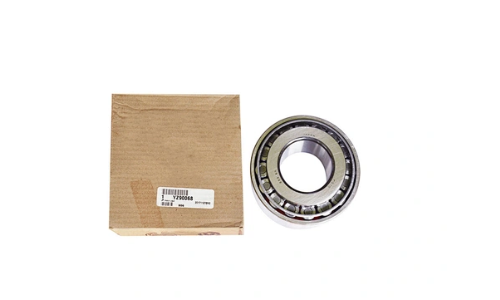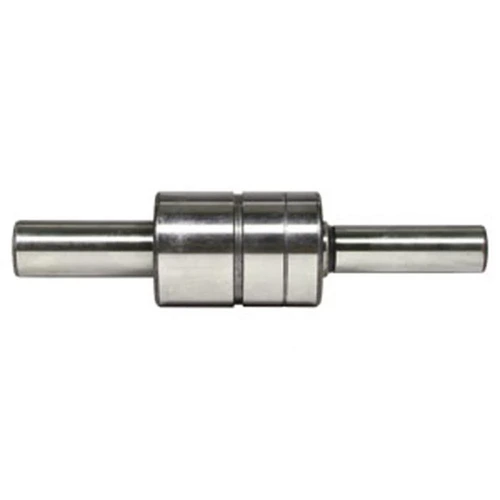Tapered roller bearings are a type of rolling element bearing designed to handle both radial and axial loads (thrust) simultaneously. They consist of four main components: the cone (inner ring), the cup (outer ring), tapered rollers, and a cage that holds the rollers in place.
Tapered roller bearings, first introduced in the early 20th century, continue to be a versatile and reliable choice for numerous applications. Their ability to withstand loads from multiple directions and perform efficiently at high speeds makes them ideal for heavy duty tasks.
The terminology and load ratings for tapered roller bearings differ slightly from those of ball bearings and other types of roller bearings. Instead of an outer ring, they feature a cup, and instead of an inner ring, they have a cone. The other components, such as the cages and rollers, are named similarly across bearing types. However, the defining characteristic of tapered roller bearings is the shape of the rollers, which are tapered. This creates line contact between the raceways of the cup and cone, unlike the oval contact seen in spherical roller bearings or the point contact in ball bearings.
Another key distinction lies in how load capacities are defined. The dynamic capacity is often used to describe a bearing's load carrying ability as it relates to fatigue resistance. For most bearings, the dynamic capacity (C) is the load under which 90% of a set of bearings will achieve or exceed one million revolutions. However, for tapered roller bearings, the dynamic capacity (C90) is defined as the load at which 90% of bearings will reach ninety million revolutions. Initially, the published dynamic capacities for tapered roller bearings may seem lower than those for other roller bearings. However, this is due to the difference in the reference base. To compare C90 to C on the same scale, multiply the C value by 0.259.
Advantages
1. High Load Carrying Capacity
Tapered roller bearings are designed to handle both radial and axial loads simultaneously. Their geometry allows them to support heavier loads than other bearing types, especially when the load is directed both vertically and horizontally.
The design of tapered roller bearings promotes true rolling motion of the rollers between the raceways, reducing the risk of skidding or sliding, even when unloaded. This is a major benefit compared to other types of roller bearings, which need a minimum load to ensure proper rolling action and prevent sliding. Skidding or sliding is detrimental as it pushes lubrication away from the contact surfaces, leading to wear and premature bearing failure.
2. Axial Load Support in Both Directions
While they naturally handle axial loads in one direction, tapered roller bearings can also support loads in both directions when used in pairs or sets, providing flexibility in complex loading environments. Their tapered and angled rollers, positioned between the cup and cone, enable them to support a wide range of directional loads. They excel at handling heavy combined thrust and radial loads, outperforming spherical, cylindrical, or needle roller bearings. In most standard mounted configurations, tapered roller bearings can handle pure radial, pure axial, or any combination of these loads without requiring modifications.
3. Durability and Long Life
Their design allows for better distribution of stress across the rollers, reducing the chances of fatigue failure and making them more durable in high-load or shock-load applications.
4. Low Friction
Due to the line contact between the tapered rollers and raceways, friction is reduced, resulting in smoother operation, less heat generation, and more efficient performance, even at higher speeds.
5. Precise Load Distribution
The unique tapered geometry ensures that load distribution is optimized, minimizing stress concentrations and ensuring consistent performance across the bearing's lifespan.
6. Adaptability to Misalignment
Tapered roller bearings can tolerate small misalignments between shafts or housings, making them adaptable to applications where slight misalignment is common, without a significant reduction in performance.
7. Ability to Handle Impact and Shock Loads
Their robust design makes tapered roller bearings well-suited for heavy-duty applications such as automotive axles, industrial machinery, and construction equipment, where impact and shock loads are common.
8. Customizability and Versatility
Tapered roller bearings are available in many different sizes, materials, and configurations, allowing them to be customized for specific applications. This versatility makes them ideal for use across a variety of industries.
Application
1. Automotive Industry
Wheel Hubs: Tapered roller bearings are commonly used in vehicle wheel hubs, especially in trucks and SUVs, to support both radial loads from the weight of the vehicle and axial loads from turning and cornering. Differentials and Axles: They are essential in automotive axles and differentials, where they manage the combination of radial and thrust loads.
Transmissions: Used in vehicle transmission systems to ensure smooth rotation of gears under heavy load conditions.
2. Heavy Machinery and Equipment
Construction Equipment: Tapered roller bearings are found in excavators, bulldozers, and cranes, where they handle the extreme loads and vibrations typical of construction environments.
Agricultural Machinery: They are used in tractors, harvesters, and plows to manage heavy radial loads combined with thrust loads.
Mining Equipment: In machines like conveyors and crushers, tapered roller bearings are used for their ability to withstand the high impact and heavy loads common in mining operations.
3. Industrial Applications
Gearboxes and Reducers: Tapered roller bearings are employed in industrial gearboxes and speed reducers to manage heavy radial and axial forces.
Machine Tool Spindles: In lathes and milling machines, they ensure precision and stability under significant load conditions.
Conveyor Systems: They support conveyor rollers and pulleys in various industries, including manufacturing and material handling.
4. Railways
Railroad Axles: Used in train axles, tapered roller bearings handle the heavy loads and constant stress from the train’s weight and movement, ensuring reliable performance.
Locomotive Gearboxes: They are critical components in the gearboxes of locomotives, where they handle high load capacity while reducing friction.
5. Wind Turbines
Tapered roller bearings are employed in wind turbine main shafts and gearboxes, where they support both the axial and radial loads generated by wind forces and rotational movements.
6. Marine Industry
Propeller Shafts: In marine engines, they are used in propeller shafts and gearbox assemblies to handle the combination of thrust and radial loads during propulsion.
Steering Systems: Found in steering mechanisms, they ensure smooth operation under varying loads.
7. Aerospace
Tapered roller bearings are used in aircraft landing gear, engines, and rotary components, where they must endure high speeds, heavy loads, and demanding conditions.
Explore our extensive selection of tractor components, including roller bearing designed for excavators. CXNOFIA, a renowned manufacturer from China, offers high quality roller bearing at competitive prices. Enjoy fast global shipping, hassle free returns, and take advantage of our limited time offers! 


